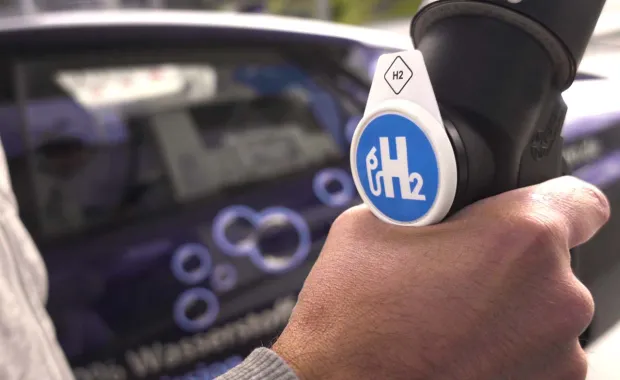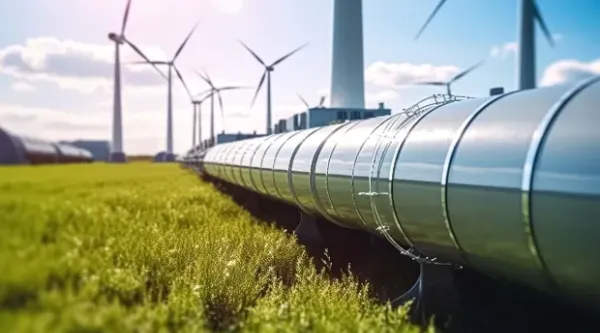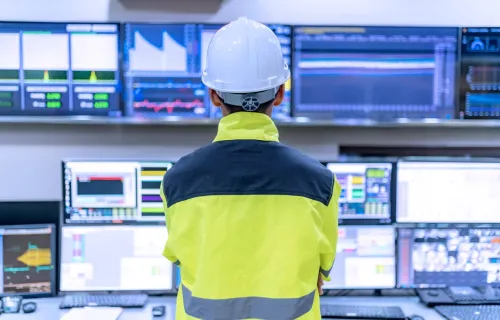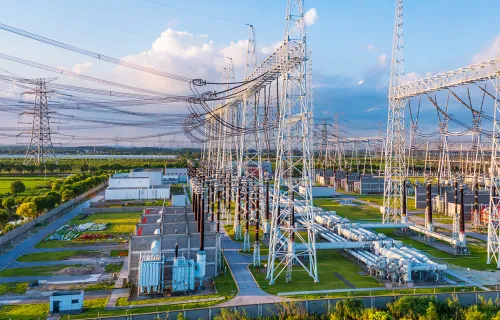C’est une période riche en défis pour le marché de l’énergie. La fluctuation des coûts énergétiques et l’engagement envers l’objectif zéro émission nette de carbone accélèrent la transition vers une énergie verte. Toutefois, il devient de plus en plus difficile de prévoir la croissance de la demande pour des sources d’énergie renouvelable et des ressources énergétiques distribuées, de même que les tendances en matière de consommation et de production.
La nature saisonnière et imprévisible de l’énergie solaire et éolienne nous pousse de plus en plus à porter notre attention sur le stockage de l’énergie et sur la flexibilité du marché. Voici comment l’hydrogène peut jouer un rôle clé.
Étant un vecteur énergétique, l’hydrogène peut être stocké et transporté de l’endroit où il est produit à l’endroit où il est requis, ce qui ajoute une nouvelle dimension à la gestion du marché de l’énergie. À l’heure actuelle, l’hydrogène est principalement produit à partir de combustibles fossiles comme le gaz naturel, qui est utilisé comme charge d’alimentation dans les procédés chimiques. Ce type d’hydrogène (appelé hydrogène gris ou d’origine fossile) libère du dioxyde de carbone dans l’air, ce qui en fait un combustible ayant une forte empreinte carbone. À l’avenir, il faudra plutôt miser sur une forme d’hydrogène durable appelé hydrogène vert ou hydrogène d’origine renouvelable. L’hydrogène vert est produit à partir d’électricité provenant d’énergies renouvelables, selon un procédé qui décompose l’eau en hydrogène et en oxygène appelé électrolyse. Ce procédé ne génère pas de CO2, ce qui en fait la forme la plus propre de combustible à base d’hydrogène.
Comme la demande d’hydrogène provient principalement des secteurs d’activité, on peut s’attendre à ce que la première vague de transition vers une économie d’hydrogène soit également axée sur les besoins de l’industrie. Les secteurs d’activité qui utilisent de l’hydrogène gris devront passer à l’hydrogène bleu ou à faible empreinte carbone (qui est produit à partir de combustibles fossiles, mais dont le CO2 est capté), puis à l’hydrogène vert à long terme. La prochaine vague sera axée sur la mobilité. « L’hydrogène est une solution de rechange intéressante pour les véhicules lourds et voyageant sur une longue distance, ainsi que pour l’aviation et le transport maritime et ferroviaire », affirme Martijn.
Actuellement, l’hydrogène est une toute nouvelle solution. Il n’y a ni marché, ni infrastructure de transport, ni processus, et très peu de réglementation. « C’est un bon moment pour créer un marché international de l’hydrogène plus cohérent dans lequel il est beaucoup plus facile de faire des échanges transfrontaliers et d’accéder aux marchés des différents pays », explique Martijn.
Pour favoriser la création d’un tel marché international ouvert, la mise en place de règlements qui soutiennent la croissance et l’intégration de l’hydrogène est nécessaire. Nous nous butons toutefois au problème de la poule et de l’œuf. L’excès de réglementation est susceptible de nuire à l’innovation, mais sans règlements, les gros joueurs sur le marché risquent de déterminer toutes les règles du jeu.
Comme point de départ, il serait bon de s’entendre sur certains principes clés fondés sur les leçons tirées de la décomposition et de la libéralisation des marchés de l’électricité et du gaz. Il faut entre autres assurer la transparence, un accès égal aux infrastructures et une surveillance adaptée. L’adoption d’une approche itérative à l’égard de la réglementation permettra de tirer des leçons des réussites et des échecs en cours de route.
De plus, des organismes de surveillance indépendants doivent soutenir des pratiques commerciales équitables, à l’instar de l’Agence de l’Union européenne pour la coopération des régulateurs de l’énergie (ACER), qui a été mise en place pour les marchés du gaz et de l’électricité. « À mon avis, nous ne pouvons garantir un marché équitable qui offre des chances égales aux entreprises que si nous le réglementons. Pour ce faire, nous devons mettre sur pied des organismes de réglementation adaptés pour prendre en charge ces marchés », ajoute Martijn.
L’hydrogène présente un immense potentiel pour favoriser la décarbonation dans tous les secteurs. Toutefois, de nombreuses questions demeurent sans réponse. Quelle est la façon la plus efficace d’exploiter des actifs comme un électrolyseur, du point de vue de la température et de la sécurité? Comment les gens percevront-ils l’hydrogène et son adoption?
Les vallées de l’hydrogène aident à trouver des réponses à ces questions. Une vallée de l’hydrogène se définit comme un mini marché. Il s’agit habituellement d’une initiative locale ou régionale dans le cadre de laquelle l’hydrogène est produit, transporté et consommé dans différents marchés. Ce mini marché constitue l’environnement idéal pour expérimenter et voir ce qui fonctionne ou ne fonctionne pas, pour déterminer les améliorations à apporter et élargir les horizons au fil du temps.
« À l’heure actuelle, on se concentre surtout sur les actifs et le volet opérationnel, et pas assez sur les données. Quels sont les principaux sujets à aborder à l’avenir du point de vue des données? », demande Tom.
Les données seront essentielles pour faciliter la transparence, la surveillance et la collaboration dans le cadre de projets ainsi que le suivi des gros investissements des secteurs privé et public dans les vallées de l’hydrogène. Il sera également important de soutenir le couplage entre le futur marché de l’hydrogène et le marché actuel de l’électricité. Un fournisseur d’énergie qui utilise des sources d’énergie verte renouvelable et qui est actif sur le marché de l’hydrogène peut devoir s’attaquer à de nombreux défis et enjeux d’optimisation nécessitant une mise à profit des données sur toute la chaîne de valeur. Par exemple, il doit déterminer à quel moment l’énergie doit être transformée en hydrogène et comment la stocker et la vendre. « La prévisibilité ainsi que le fait de combiner les données et de s’assurer de bien gérer tous vos actifs sont des aspects dont j’aimerais voir l’évolution dans les cinq, dix et quinze prochaines années », affirme Martijn.
En outre, à mesure que des pays non européens commencent à produire et à exporter de l’hydrogène, les certificats ou garanties d’origine seront essentiels pour en vérifier la source ainsi que la quantité d’émissions de gaz à effet de serre (GES) induite par la production. La planification et l’adoption d’une solution centralisée qui appuie les processus du marché et l’échange de données peuvent changer la donne.
- Chapter 1: Introductions
-
Tom van der Leest:
Hello, everyone. Very nice of you all to join us for another podcast here from CGI. My name is Tom van der Leest and I’m within CGI responsible for one of the business units focusing on energy and utilities in the Netherlands, specifically the Northern part of the Netherlands. And with me here today is Martijn. Martijn and I have worked for many years on energy projects in the Netherlands and I’m very happy to have you on board today. Martijn, how are you today.
Martijn Frints:
Very good. I’m delighted that we can do this today. So, let’s get on with it.
Van der Leest:
Awesome. Well let’s have a good chat about some cool new market developments that are heading your way. So, as mentioned before, we’ve worked quite closely on the Dutch energy market and specifically energy data management. And, in the past few years we’ve seen more and more emphasis on renewable management and renewable energy in the energy mix. I see it for clients in the Northern part of the Netherlands like the Dutch gas DSO. But I think with your client base you also see loads of developments heading into that direction. What’s your take on it?
- Chapter 2: Current challenges
-
Frints:
Well, if you look at what's happening now recently, and I think the Dutch market situation is quite extreme. Last year, we had a lot of energy suppliers that are failing because wholesale prices are going through the roof. We have gas prices that are soaring. So, we are in a very, very challenging market at the moment.
We see that we have a very nice ambition to be climate neutral by 2050. We want to reduce our emissions by 55% when we're in 2030. And that means that well throughout all the sectors, we see that we need to accelerate. So that's not only in the electricity or gas sector, but that's also in industry. That's also in the sectors where, in mobility, we see that we need to make a lot of steps to make sure that we introduce more and more renewables. But as a consequence, what you see is that it's more difficult to predict how we use our energy, how we consume, how we produce, what the future will bring, will be a bit unclear. But least there is a need to transport a lot of energy from where you produce it to where we need to consume it.
And if we want to be more and more green, that's going to be a bigger and bigger challenge.
-
Chapter 3: Market impact of rise in renewable energy
-
Van der Leest:
We obviously talked a lot about the time working together about how the energy market is becoming more and more unpredictable. And we've spoken a lot about how renewable energy is like less predictable by nature and how that's emphasized by the way that we consume it either through electric vehicles or through solar panels on the roof or anything in between. So, we are now accustomed to wind energy and solar energy as being part of the electricity systems. What's your take on new renewable energy sources coming towards the market.
Frints:
It could be very interesting to transform the excess of energy that you have in periods with a lot of wind or a lot of sun, so that you can use it at a later moment, by transport and transforming it into hydrogen, because well, when you then use it, you only produce water and energy. So, there is no CO2 that comes into the picture there.
- Chapter 4: Emerging hydrogen opportunities
-
Van der Leest:
Well, it's quite an interesting thought that if you have a new commodity like hydrogen, that kind of brings a new dimension to the way energy management works, right? Because you have something you can now store the energy with even though that in the past, it should always be balanced, consumption towards productions, and it's quite hard to store it.
And obviously hydrogen has been a kind of controversial topic over the last period since its commercial use is not in a really mature stage. And I think, we've discussed this before that we see kind of a lot of potential for hydrogen in different sectors, but that potential differs, both in maturity and the way it holds potential. So …
The application of hydrogen that kind of happens in different sectors at different moments in time. Right. And, if you look at the outlook, if we move forward to where are we going to use hydrogen first, and what kind of waves, if you will, will we experience looking at that commodity? What, what's your take on that?
Frints:
When you look at hydrogen, it seems promising for a lot of different sectors. So, if you look in the industrial sector where you use it as a feed stock, that's one of the first most convenient industries that you can move towards a more sustainable form of hydrogen. First interesting step, what you can do is try to capture the carbon that the CO2 is currently just being released in the air. If you produce hydrogen from natural gas and you capture the CO2, then we call it blue hydrogen. In essence, hydrogen is of course the same, but you don't release the CO2 in the air.
- Chapter 5: Hydrogen in the production process
-
Van der Leest:
It’s kind of what you see large companies like Tata are still doing right now, right. Having the initiative to move towards more hydrogen in their production process rather than the conventional energy sources.
Frints:
For companies like Tata, for example, if they need high temperatures in their production process to make steel, typically what they use is they burn natural gas. Burning natural gas releases, of course, CO2. In essence, that's not what we want, at least in a couple of years, and happily that's still far away. So, we have time to make the necessary steps there.
But if you don't burn natural gas, you still need to reach those high temperatures and switching to electricity is not really a viable option.
Then hydrogen is actually one of the only, well maybe the only, alternative that you then have. That's one step what they need to do there. So that's an industrial wave that you can see that you see coming.
So, the first wave would be everything where we already use hydrogen, moving from there to a more, well, a first step to blue form of hydrogen, or introducing green hydrogen there, already as well.
A second step is more in the mobility area, where of course people then first would think of hydrogen-powered, fuel-cell-powered, cars. If, you look at the Netherlands or in Europe, battery electric is kind of winning that battle, but for long haul, for heavy transport or aviation or for shipping or for rail where you don't have, really, electricity-powered trains there, hydrogen is a very interesting alternative for the future.
- Chapter 6: The hydrogen color spectrum
-
Van der Leest:
Well, it's funny that you refer back to these colors because I keep getting that picture in my head of that commercial of the energy retailer offering green energy and the consumer actually smelling the electricity sockets to understand whether the electricity he was getting was actually green or not on how he could smell it.
If you look back at the different types of hydrogen that we use, and I heard you talking about blue, gray, green, what's the difference? What kind of types do we have, and how does that work?
Frints:
So then, for gray hydrogen, that's the hydrogen that's currently mostly used, it's produced from natural gas. It releases the CO2 in the air.
If you captured on the CO2, we call it blue hydrogen. The hydrogen is exactly the same, but, but you captured the CO2.
Green hydrogen is not made from natural gas. It's made through electrolysis. That's a difficult word. It means you use electricity through water, and then you split the water into H2 and O2, so oxygen and hydrogen. If you do that with green energy, we call it green hydrogen that comes out. If you use it with, energy from a nuclear power plant, we call it pink energy. And, of course if you use it from gray energy, I think we call the hydrogen yellow, I believe. In the end, the most sustainable form would be the green one. So, we're trying to focus more on moving towards a green hydrogen economy.
Van der Leest:
No, I think you get it. So, given that hydrogen is not its own energy source, we’re looking at what energy sources do we use to produce it, and that gives it a certain determination in that we translate into a specific color.
Frints:
Exactly yeah. You can't find hydrogen as a source of energy somewhere in the ground, so you have to create it. So that's where we don't say it's an energy source, but we call it an energy carrier. You can use it to store your energy. You can use it to transport your energy. If we actually move then to large-scale use of hydrogen, there are a lot of challenges that we then need to fix because, well, we need also to store that hydrogen on a large scale, we need to transport it on a large scale, and we need to make sure that there is a nice market that facilitates all this. Those are all steps that we're not there yet. That makes this feel so interesting for the upcoming years.
- Chapter 7: Energy market management
-
Van der Leest:
Yeah. There is loads in the energy and utility markets on regulations and how a market is developing. And unlike electricity and gas, if you will, you see an existing regulatory shape in which processes happen, in which there is a market where we trade, produce, consume [and] transport. And all these things seem, for hydrogen, as if we are at the very beginning of this transition. What I would be quite interested to know is how you view this market and how it will evolve and what steps are good to take first.
Frints:
I think you're completely correct here. It's very greenfield. We don't have a hydrogen market. We don't have a hydrogen transport infrastructure. We don't have processes. We have very little regulation, if any in this area. And that makes it very interesting. If you look at the electricity and gas markets, each country had already their own electricity and gas markets, so you will, or they liberalized their own markets. But throughout Europe, all those markets are liberalized at their own pace. So, although you can see similarities between the countries, the actual market model between the countries kind of differs, from country to country.
With hydrogen, everything is now greenfield. It feels like a great opportunity to make now a step and create a more consistent international market in which it's much easier to trade cross border and access each other's markets.
So that means that also regulation has to be made and has to be put in place that facilitates this, but this is a bit the chicken and the egg. You don't want to overregulate because then all the innovation of the market is gone, and you don't want to stop or not regulate at all and have some major commercial players step in and determine all the rules of the game.
So, we have to find a way to sit there, in the middle. And most likely, in my head, it makes sense to at least agree on some key principles for this regulation, where we base ourselves on what we have learned in all the unbundling and liberalization processes that we went through in the individual electricity and gas markets.
- Chapter 8: Energy market lessons learned
-
Van der Leest:
Yeah. It seems like a golden opportunity to learn from past mistakes or like, the money that we spend on going from a very isolated national utility market toward a more international oriented market. And at the same time, it [makes for] funny discussions, right, because in the electricity market, it's the TSO regulated to zero that's responsible for transporting it. Whereas with this greenfield hydrogen, you could even argue that a commercial company would be responsible for transporting hydrogen. Do you think that these kinds of key principles should be covered first? Or is that also up for debate?
Frints
Yeah, I think there's some key principles that are essential—that it's important to agree on it. We pushed quite hard on unbundling in the utility markets to make sure that the regulated part and the commercial part are separated. So it would make sense that if we spent so much time unbundling, that will be a key principle in this new upcoming hydrogen economy, similar to all the necessary transparency rules. And the fact that if you have infrastructure in the ground, that that other parties can access that infrastructure, that you're not being discriminated because you are from another country or from another type of company or whatever, so that everybody has the rights to access it. That there's the proper amount of monitoring, that there is a regulatory body that is there to maintain the oversight over that field. I think those are the least the principles that we should agree on, and then make sure that the regulation has some iterative character that you can adapt and learn from what works and what doesn't work.
- Chapter 9: The concept of Hydrogen valleys
-
Van der Leest:
Yeah. And I think that experimenting, what works and what doesn't work, is kind of happening in these smaller initiatives, but what we tend to call hydrogen valleys. And I think we're even involved in some of them.
Frints:
So, yeah, you're right. I think, you are, since a few months now responsible for our energy market in the north of the Netherlands and there we have one of the first hydrogen valleys, or maybe the first hydrogen valley, in Europe. Well, hydrogen valley is something like a mini market. It's typically a local or regional initiative where hydrogen is produced, transported, consumed in different markets. Those are ideal situations where you can actually try what works and what doesn't work. And there are a lot of questions that still need to be answered and not all those questions are based on which regulatory framework is good. We have a lot to figure out on what are the best ways to operate? And electrolyzer, temperature wise, what are the safety risks that are involved? How will people look a hydrogen? How, how will adopted? So we have, we have a lot of questions that need to be answered, and these smaller hydrogen valleys, where also European funds are typically part of it to accelerate the implementation of new initiatives. Those are ideal places to check and see what works.
Van der Leest:
I think in the Northern part of the Netherlands, we traditionally have natural gas production and the Gas DSO they are responsible for its transport, and they we've now taken the decision in this country to get off the natural gas and try to find different ways. And obviously the government has asked the gas DSO to think about its role in this new hydrogen economy. I think the mini market description is quite fitting. I also recognize that view that you share that is focusing quite strongly on the asset side, making it work, how do we actually operate an electrolyzer? How do we get it into a bus? How do we monitor what happens with it? And at the same time, it doesn't feel that there's a lot of emphasis on the data side yet. If you look at that data side moving forward, what are some key topics you think that the focus should be on in these early days of this new market?
- Chapter 10: The need for market transparency
-
Frints:
Yeah, as I said, typically there's a lot of money involved here from private companies, but also from governmental bodies and from Europe, for example. So, there's typically a big need for transparency and a lot of insight in this is what the position, this is how much hydrogen is created. This is what we have been doing with it over time. So, what we feel is that is important to have a well, a detailed view, a steady view on this is what is going on in hydrogen. These are the assets, these are the parties that are involved so that you can track and trace it over time, that you can provide all the reporting and dashboarding that you need to show what has been done with all the investments that are in there.
But if you look further ahead, then we, we come back to that coupling with the electricity markets, that coupling is essential. In the end, hydrogen is going to be produced from electricity. And hopefully also from a lot of green electricity. That means that the market's coupling between the future hydrogen market and the current electricity market is one of the big challenges that we see. So if you put yourself in a position that you would be an energy supplier in the future with a lot of green renewable energy sources that you're using, and you are also active on the hydrogen market, you will find yourself in a position that you have a lot of difficult challenges and optimization questions that you will have to solve, because, well, what will you do?
Will you sell your energy on the day ahead market or on the flexibility market to do something with congestion? Will you transform it to hydrogen and sell it on the hydrogen market?
Will you transform it to hydrogen and keep it for yourself so that when you, and store it for yourself, so that at moments where there's a lot of electricity demand that you can convert it back on different places. Those challenges require a lot of data over the whole chain, and requires a lot of insight in what do you think will happen with the market? So, predictability, combining that data, making sure that you can steer all your assets in the proper way, is something I'm really interested in how this will evolve in the upcoming 5, 10, 15 years.
- Chapter 11: Hydrogen certificates of origin
-
Van der Leest:
Well, it's an interesting development. Also, if you look at the certificates of origin, right, it'd be different colors and how you keep track of those, but how you keep track of how stuff works and how you validate things. I think in our joint experience in the Dutch market, we know how complex it can be if you do this in a central solution for all the market processes. So thinking about that early on seems like a good thing
Frints:
Yeah. I think the certificates of origin is also very interesting. In the end, not all the hydrogen that we will use in Europe will be produced here. We will see a lot of import as well. And I think we see harbors also looking with a lot of interest in this. We see countries trying to become a net exporter of hydrogen. And somehow you need a way, if companies need to report on their own CO2 footprint, if they would use then hydrogen, you would need to know how is this hydrogen then produced. So also, this whole certification of origin, making sure that from the moment that you create the hydrogen, until the moment that you use the hydrogen, that you can track how that has been going and what the CO2 footprint has been is one of the most important things to guarantee that we're on the right track for our 2050 goals.
- Chapter 12: Need for market oversight
-
Van der Leest:
And that's interesting, right? That, it's not a national thing, it's an international development. And I think that with existing energy markets, we have some international oversight, if you will, on making sure that we work on an equal footing of different countries, and we we're correct in the things that we are reporting and producing and consuming. So, if you look at ACER, how they do that now for the electricity market, what do you think we need similar kind of types of organization to manage this field of hydrogen?
Frints:
I think we really do, because I think we can all only guarantee that this market will operate as a fair market with equal opportunities for companies that are there if we regulate it. Which also means that we need the proper regulatory bodies that are responsible for these markets. I applaud the large energy companies to invest in hydrogen and make these steps. And I think that's essential and they can make a serious difference. At the same time, I think we should be hesitant in creating a world where only the large corporations and large energy companies will determine exactly how that future looks like.
Van der Leest:
Yeah. And I think organizations like ACER1 or these oversight organizations kind of get that independent assessment on how that market works. Because the thing you mentioned earlier about storing hydrogen for a later moment in time, and you know, taking that into account with trading or supply and demand estimations, it can lead to quite a strong commercial gain as well if these markets are so intertwined. So, it makes sense to make sure a nondiscriminatory and transparent over the international playing field.
Frints:
Now, currently, it's relatively small. We're talking about millions and millions of euros, but in the bigger scheme of things we're currently in the beginning. So, I believe that if we now do the smart things, we can make sure that we don't need to do a lot of corrections and complex unbundling in the future.
1 EU Agency for the Cooperation of Energy Regulators - https://www.acer.europa.eu/
- Chapter 13: Hydrogen’s role in net-zero
-
Van der Leest:
Yeah. And I think it can help with a few other topics as well. Right? Because we started off talking about the 2050 goals and the zero-emission kind of society and how hydrogen plays a role in that. Then, at the same time, looking at our current commodities with issues with congestion and low voltage parts of the grids, that if we have streets in which we all plug in 10 electric cars, we really have an issue. It speaks to the imagination on how hydrogen can play a role in things like flexibility in the market or storage, and optimization challenges for producers.
Frints:
Yeah, exactly. And I think you can see different scenarios and you can have. On one hand, there's the scenario where we see people lowering their energy consumption, having a lot of local production and local storage of energy, maybe even local production of hydrogen, if the business case is possible for that at some point in the future. And on the other hand, we see the very large-scale offshore green energy production with maybe even offshore largescale electrolyzers, and which also fuels the need for a large, transport system of that energy. And it is just everything is possible. And, probably the truth will be somewhere in the middle. But I think it's too early to now say that it will be either one or the other.
Van der Leest:
Well, it sure seems like an exciting time to be not only in the goal setting towards the zero-emission society, but more so also in the field of energy, data management and what you need to do as an organization to learn from past mistakes and do this well.
I think that as a wrap up there are some key takeaways, if I understood you correctly, is that hydrogen in all its different colors seems quite promising for the future, where we should kind of focus on that green hydrogen and trying to get that economically viable. At the same time, the future is still uncertain.
So, we need to work on multiple scenarios to see what fits the large international kind of model in which will have large volume production and transport towards far more, the local decentralized production and usage of hydrogen and the need to get a regulatory framework that will support this growth of this commodity. And I think that one of the key things that is kind of in between the lines is to think big, but start small by focusing on these hydrogen valley initiatives, but keep in mind how we can scale that up over time.
Frints:
Yep. I think that's a very, very good summary. Thanks.
Van der Leest:
Well, thanks for joining us today and thanks for those insights Martijn.
Frints:
Thank you for inviting me.
Van der Leest:
Hopefully after all these years in the Dutch energy market, we will find some more years to work on the development of this exciting new commodity, right?
Frints:
I look forward to it Tom.
Cheers. Bye. See ya.







